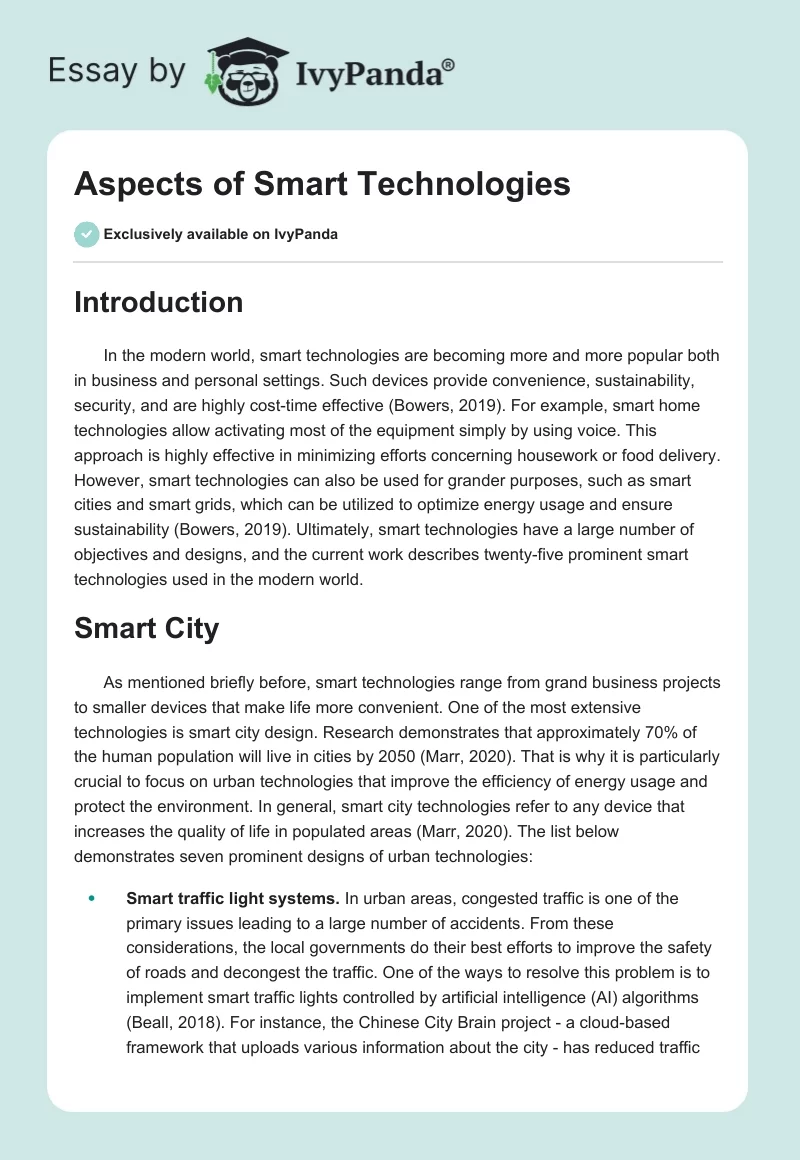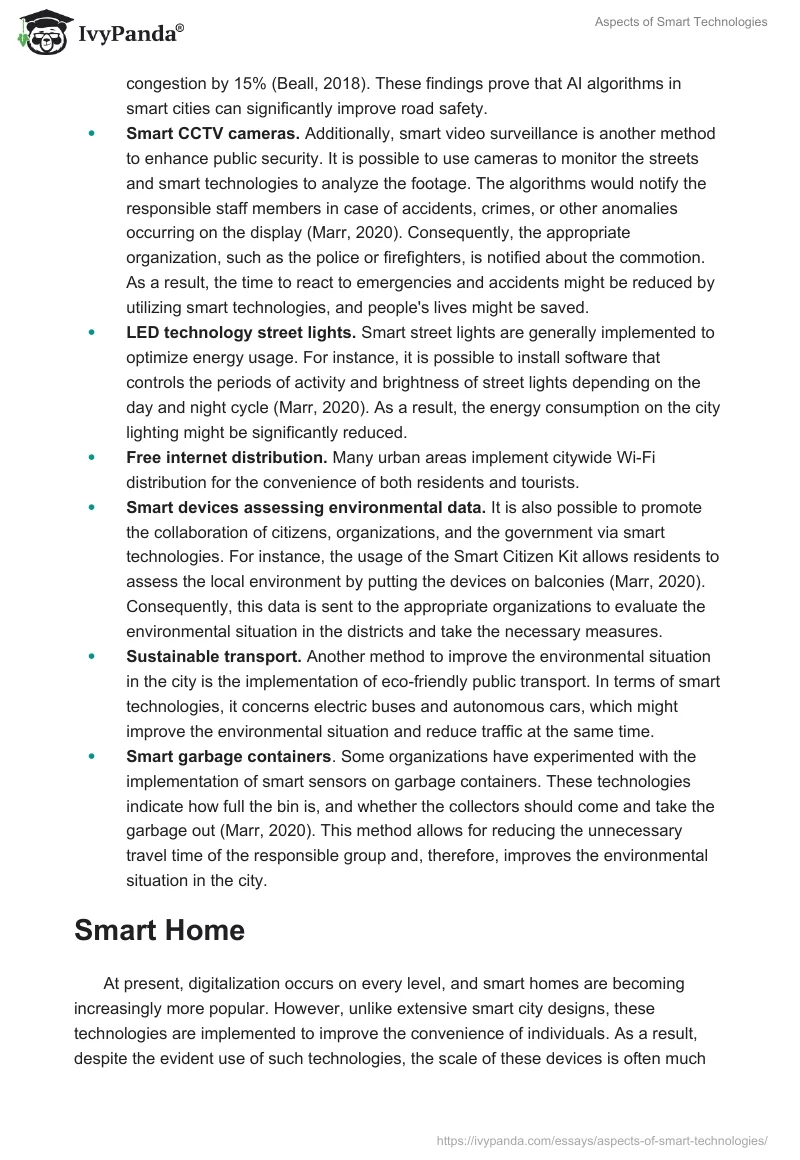Introduction
In the modern world, smart technologies are becoming more and more popular both in business and personal settings. Such devices provide convenience, sustainability, security, and are highly cost-time effective (Bowers, 2019). For example, smart home technologies allow activating most of the equipment simply by using voice. This approach is highly effective in minimizing efforts concerning housework or food delivery. However, smart technologies can also be used for grander purposes, such as smart cities and smart grids, which can be utilized to optimize energy usage and ensure sustainability (Bowers, 2019). Ultimately, smart technologies have a large number of objectives and designs, and the current work describes twenty-five prominent smart technologies used in the modern world.
Smart City
As mentioned briefly before, smart technologies range from grand business projects to smaller devices that make life more convenient. One of the most extensive technologies is smart city design. Research demonstrates that approximately 70% of the human population will live in cities by 2050 (Marr, 2020). That is why it is particularly crucial to focus on urban technologies that improve the efficiency of energy usage and protect the environment. In general, smart city technologies refer to any device that increases the quality of life in populated areas (Marr, 2020). The list below demonstrates seven prominent designs of urban technologies:
- Smart traffic light systems. In urban areas, congested traffic is one of the primary issues leading to a large number of accidents. From these considerations, the local governments do their best efforts to improve the safety of roads and decongest the traffic. One of the ways to resolve this problem is to implement smart traffic lights controlled by artificial intelligence (AI) algorithms (Beall, 2018). For instance, the Chinese City Brain project – a cloud-based framework that uploads various information about the city – has reduced traffic congestion by 15% (Beall, 2018). These findings prove that AI algorithms in smart cities can significantly improve road safety.
- Smart CCTV cameras. Additionally, smart video surveillance is another method to enhance public security. It is possible to use cameras to monitor the streets and smart technologies to analyze the footage. The algorithms would notify the responsible staff members in case of accidents, crimes, or other anomalies occurring on the display (Marr, 2020). Consequently, the appropriate organization, such as the police or firefighters, is notified about the commotion. As a result, the time to react to emergencies and accidents might be reduced by utilizing smart technologies, and people’s lives might be saved.
- LED technology street lights. Smart street lights are generally implemented to optimize energy usage. For instance, it is possible to install software that controls the periods of activity and brightness of street lights depending on the day and night cycle (Marr, 2020). As a result, the energy consumption on the city lighting might be significantly reduced.
- Free internet distribution. Many urban areas implement citywide Wi-Fi distribution for the convenience of both residents and tourists.
- Smart devices assessing environmental data. It is also possible to promote the collaboration of citizens, organizations, and the government via smart technologies. For instance, the usage of the Smart Citizen Kit allows residents to assess the local environment by putting the devices on balconies (Marr, 2020). Consequently, this data is sent to the appropriate organizations to evaluate the environmental situation in the districts and take the necessary measures.
- Sustainable transport. Another method to improve the environmental situation in the city is the implementation of eco-friendly public transport. In terms of smart technologies, it concerns electric buses and autonomous cars, which might improve the environmental situation and reduce traffic at the same time.
- Smart garbage containers. Some organizations have experimented with the implementation of smart sensors on garbage containers. These technologies indicate how full the bin is, and whether the collectors should come and take the garbage out (Marr, 2020). This method allows for reducing the unnecessary travel time of the responsible group and, therefore, improves the environmental situation in the city.
Smart Home
At present, digitalization occurs on every level, and smart homes are becoming increasingly more popular. However, unlike extensive smart city designs, these technologies are implemented to improve the convenience of individuals. As a result, despite the evident use of such technologies, the scale of these devices is often much smaller than those of the smart city. The following list presents nine technologies, which are often utilized in smart homes:
- Smart lights. Smart lights are one of the most iconic smart home technologies. They allow changing the indoor and outdoor lighting depending on the time and preferences of the owner (Moscaritolo, 2021). Additionally, it is possible to activate them by using voice or sounds, and most smart lights are easy to install and maintain.
- Smart security system. Security is one of the most crucial functions of smart homes, and there are many ways to improve it. For instance, smart outdoor cameras might be highly useful for houses, while video doorbells are effective for apartments (Moscaritolo, 2021). Combined with smart locks, it is possible to significantly improve home safety.
- Smart speakers. Smart speakers generally refer to the command center, which controls most technologies in the house. The functions of this device include the activation of music, assistance platforms (Alexa, Siri, etc.), or even smart lights.
- Smart thermostat. The temperature indoors is an important factor, and a smart thermostat allows regulating it depending on the preferences of the owner and time of year.
- Smart pet cameras. This technology might also be highly useful for pet owners who cannot spend much time indoors. Such cameras allow for monitoring the pets, regulating the amount of food, and even organizing video chats for animals to see their owners.
- Smart kitchen appliances. Kitchen appliances primarily include smart ovens, microwaves, coffee makers, and other utensils.
- Robot vacuum. Robot vacuums have been relevant for many years; however, the technologies are constantly improving. Modern devices use AI algorithms to avoid various obstacles and are highly effective in keeping the rooms clean.
- Smart air conditioner. Similar to a smart thermostat, contemporary air conditioners evaluate the temperature and humidity in the house and are activated under certain conditions.
- Smart toilet. The features of a smart toilet include the opening and closing systems of drawers in the restrooms, self-cleaning functions, and heated seats.
Smart Individual Devices
Consequently, devices of a smaller scale, such as smartphones, smartwatches, or garments, are highly important to a large number of people in most parts of the world. Moreover, many smart technologies are not visible at first glance. For instance, smart AI chips are irreplaceable components of various modern devices (Braga, 2019). The list below demonstrates nine smart technologies on the personal level:
- Smartphones. Smartphones are some of the most prominent and widely used smart technologies in the world. At present, practically every person in developed countries is acquainted with these devices.
- Smartwatches. Smartwatches are primarily used to either assess the activities or physical characteristics of the individual. The latter includes heart rate, pulse, blood pressure, and other factors.
- Activity tracker. Unlike smartwatches, these technologies take different forms; however, their primary application is to assess the activities of an individual, such as running, swimming, etc.
- Smart clothing. Smart clothing is another type of wearable technology that is used for health assessment. For instance, smart shirts can monitor the condition of the patient and diagnose respiratory diseases (42Gears Team, 2021). Additionally, smart socks might identify the development of foot ulcers, which is impossible for other types of wearable technologies.
- Smart shoes. Smart shoes have the same objectives as other types of tracking equipment; however, their primary area of assessment is running.
- Smart glasses. Smart glasses are usually connected to smartphones and provide certain information directly on the display of the device.
- Smart rings. Smart rings are generally used for two purposes: commercial and healthcare assessment. As a result, some rings are utilized as mediums for transactions, similar to debit cards and smartphone payments. At the same time, some devices in the form of a ring assess the health of the patient, similar to smart clothing and smartwatches.
- Implantables. Implantables are some of the most innovative smart technologies. For instance, certain pills with installed censors can monitor blood pressure and other physical characteristics when the individual swallows them (42Gears Team, 2021).
- Head-mounted Displays (HMDs). HMDs generally refers to the devices of augmented reality (AR) and virtual reality (VR), which have become increasingly popular over the last years.
Smart Technologies in the United Arab Emirates
The United Arab Emirates (UAE) is one of the leading countries in terms of smart technologies and their implementation. According to research by the McKinsey Global Institute, Dubai and Abu Dhabi have some of the best smart technology bases in the world (Woetzel et al., 2018). The chart depicted in Appendix A shows that these two cities demonstrate similar ratings to New York, London, Moscow, Seoul, and other major cities in various parts of the world (Woetzel et al., 2018). However, compared to other capitals, Dubai and Abu Dhabi show a relatively low number of smart technologies in the mobility sector (Woetzel et al., 2018). It means that while such technologies as 5G, Epay, and other contemporary smart designs, are highly prominent and significant in the UAE, mobility is not a relevant issue.
This factor is explained by the relatively low number of residents in the two cities. For instance, the total number of people in such urban areas as New York, London, and Moscow might reach up to thirteen million residents (World Population Review, 2021). On the other hand, approximately three and one million and a half million people are living in Dubai and Abu Dhabi, respectively (World Population Review, 2021). As a result, UAE does not need such a complex transport system and can focus on other aspects, and this data is reflected in the chart of smart technologies.
Conclusion
Smart technologies are becoming increasingly important in the daily life of many people in various parts of the world. They can improve not only individual comfort but also affect global issues, such as energy consumption and sustainability. From these considerations, extensive research is dedicated to smart city designs that make urban areas safer and eco-friendly. The major cities in the UAE are demonstrating remarkable results concerning the usage of smart technologies despite their low focus on transport issues. Ultimately, smart technologies have become highly relevant in most developed countries and will most likely be even more popular in the future.
References
Beall, A. (2018). In China, Alibaba’s data-hungry AI is controlling (and watching) cities.
Bowers, K. (2019). What is smart technology and what are its benefits?
Braga, J. (2019). The internet of small things: New applications in wearables and more.
42Gears Team. (2021). 6 different types of wearable technology you must know right now.
Moscaritolo, A. (2021). The best smart home devices for 2021.
Woetzel, J., Remes, J., Boland, B., Lv, K., Sinha, S., Strube, G., Means, J., Law, J., Cadena, A., & Tann, V. (2018). Smart cities: Digital solutions for a more livable future.


